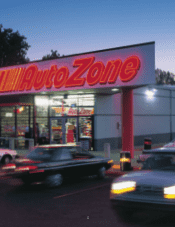AutoZone 1999 Annual Report Download - page 20
Download and view the complete annual report
Please find page 20 of the 1999 AutoZone annual report below. You can navigate through the pages in the report by either clicking on the pages listed below, or by using the keyword search tool below to find specific information within the annual report.18
Financial Market Risk
Financial market risks relating to the CompanyÕs operations
result primarily from changes in interest rates. The Company
enters into interest rate swaps to minimize the risk associated
with its financing activities. The swap agreements are contracts to
exchange fixed or variable rates for floating interest rate payments
periodically over the life of the instruments.
Liquidity and Capital Resources
The CompanyÕs primary capital requirements have been the
funding of its continued new store expansion program, inventory
requirements and more recently, acquisitions and stock
repurchases. The Company has opened or acquired 1,928 net
new auto parts stores and constructed four new distribution
centers from the beginning of fiscal 1994 to August 28, 1999.
Cash flow generated from store operations provides the
Company with a significant source of liquidity. Net cash provided
by operating activities was $307.4 million in fiscal 1999, $366.8
million in fiscal 1998, and $177.6 million in fiscal 1997.
In fiscal 1999, the Company invested $428.3 million in capital
assets including approximately $108 million for the Express real
estate and real estate leases from Pep Boys. In fiscal 1998, the
Company invested $337.2 million in capital assets and had a net
cash outlay of $365.5 million for acquisitions including the
retirement of the acquired companiesÕ debt. Acquisitions included
Chief Auto Parts, with stores primarily in California, Auto Palace,
with stores primarily in the Northeast, and a truck parts chain,
TruckPro. Capital expenditures were $295.4 million in fiscal 1997.
In fiscal 1999, the Company opened 245 new auto parts stores in
the U.S. and 6 in Mexico, replaced 59 stores and closed 191 U.S.
stores. In addition, the Company opened 3 new TruckPro stores
and relocated 6 stores. Construction commitments totaled
approximately $57 million at August 28, 1999.
The CompanyÕs new store development program requires
significant working capital, principally for inventories. Historically,
the Company has negotiated extended payment terms from
suppliers, minimizing the working capital required by its
expansion. The Company believes that it will be able to continue
financing much of its inventory growth by favorable payment
terms from suppliers, but there can be no assurance that the
Company will be successful in obtaining such terms.
In November 1998, the Company sold $150 million of 6%
Notes due November 2003, at a discount. Interest on the Notes
is payable semi-annually on May 1 and November 1 each year,
beginning May 1999. In July 1998, the Company sold $200 million
of 6.5% Debentures due July 2008, at a discount. Interest on the
Debentures is payable semi-annually on January 15 and July 15 of
each year, beginning January 1999. The Debentures may be
redeemed at any time at the option of the Company. Proceeds
were used to repay portions of the CompanyÕs long-term
variable rate bank debt and for general corporate purposes.
The Company has a commercial paper program that allows
borrowing up to $700 million. As of August 28, 1999, there
were borrowings of $533 million outstanding under the
program. In connection with the program, the Company has a
5-year credit facility with a group of banks for up to $350
million and a 364-day $350 million credit facility with another
group of banks. Borrowings under the commercial paper
program reduce availability under the credit facilities. No
amounts were outstanding under either of the $350 million
credit facilities at August 28,1999. Outstanding commercial
paper at August 28, 1999, is classified as long-term debt as it is
the CompanyÕs ability and intention to refinance it on a long-
term basis. Both of the revolving credit facilities contain a
covenant limiting the amount of debt the Company may incur
relative to its total capitalization.
Subsequent to year end, in September 1999, the Company
announced Board approval to repurchase up to $200 million of
common stock in the open market. This is in addition to the
$150 million repurchase approved in June 1999, the $150
million repurchase approved in October 1998, and the $100
million repurchase approved in January 1998. From January
1998 to August 28, 1999, the Company had repurchased
approximately $263 million of common stock. The impact of
the stock repurchase program in fiscal year 1999 was an
increase in earnings per share of $.02.
The Company anticipates that it will rely primarily on
internally generated funds to support a majority of its capital
expenditures, working capital requirements and stock
repurchases. The balance will be funded through borrowings.
The Company anticipates no difficulty in obtaining such long-
term financing in view of its credit rating and favorable
experiences in the debt market in the past. In addition to the
available credit lines mentioned above, the Company may sell
up to $50 million of public debt under shelf registration
statements filed with the Securities and Exchange Commission.
Year 2000 Readiness
The Year 2000 problem is, in its simplest terms, the inability
of computer hardware and software to properly process dates
beyond December 31, 1999. In order to save valuable system
memory, hard storage space and processing cycles, early
programmers recorded dates using only the last two digits of the
year. Year 2000 problems arise when performing date
calculations between centuries based upon two digit year fields.
The Company began addressing the Year 2000 issue in June
1996 and implemented a formal Year 2000 project office in May
1997. As of August 28, 1999, the Company had completed over
95% of its critical readiness efforts. Thus far, no significant issues
have been detected during the testing of Year 2000 ready
systems. The Company has not achieved 100% completion
primarily due to delays in receiving third party software
upgrades. The Company anticipates completing all Year 2000
efforts by December 1, 1999.
























